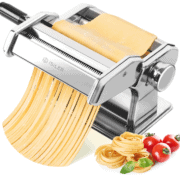This post may contain affiliate links. Please read our disclosure policy.
Learn how to make ramen noodles at home with just 3 ingredients! These homemade ramen noodles are perfectly chewy, tender, and incredibly easy to make. Use them in stir-fries, soups, salads, and more!

Making ramen noodles at home is much easier than you think and super fun!
⭐️ Why You Should Try This Recipe
- Perfectly tender and chewy. If you are looking for springy, slurpy noodles that taste like those from your favorite ramen restaurant, you will love this recipe!
- Budget-friendly. One batch will only cost you about $0.7 and serves a crowd! Plus, fresh noodles taste much better than store-bought.
- Simple method and ingredients. Flour, salt, and baking soda are the only ingredients you will need! There are no preservatives or colorings.
- It’s perfect for making homemade ramen! These noodles really shine in soups and broths. They do not fall apart or become soggy as opposed to regular noodles.
📘 What are Ramen Noodles
Ramen noodles (ラーメンの麺 in Japanese) are a type of wheat noodles very popular in Asia. They are used to make many Chinese dishes and Japanese ramen.
This type of noodle contains alkaline water, which makes them more elastic, chewier, and prevents them from getting soggy in soups or broth.

🌾 Ingredients
- Flour – I went with all-purpose flour, but you can use half all-purpose flour and half bread flour if you want slightly more chewy noodles.
- Baking soda – We are using baking soda to prepare alkaline water. You learn more about that below.
- Salt – For flavor.
What is Alkaline Water
Alkaline water, also called lye water or kansui, is a Sodium hydroxide solution used here to add color, chewiness, and flavor to the noodles. It’s a key ingredient that gives these noodles their distinct texture and flavor.
You can find food-grade lye water online or follow the instructions below to learn how to make your own from scratch using just baking soda!
🍜 How to Make Ramen Noodles
Preparing ramen noodles at home consists of 3 steps: making the alkaline water, preparing the dough, and finally, rolling it out.
1. Make the alkaline water
- Spread the baking soda on a small baking sheet lined with aluminum foil.
- Bake for about 1 hour at 250°F (120°C).
- Let it cool, and transfer it to a small container.
- You can then mix 1/4 tsp of the baked baking soda with 1 tsp of water to make enough alkaline water for one batch of noodles.


2. Prepare the dough
- Add the flour, alkaline water, salt, and 3/4 of the water to a stand mixer bowl.
- Knead on low-medium for about 1 minute or until it has a sandy texture.
- Slowly pour in the remaining water and knead again until it forms a dry dough. Note: The dough will appear dry, this is normal. Do not add more water, as you want the dough to be on the dry side.
- Shape into a ball and cover with plastic wrap to touch.
- Let the dough rest for 45-60 minutes at room temperature. The resting time will allow the gluten to develop.


3. Roll out and cut the dough
The final step is to roll the dough into a thin layer and slice it into thin strips. To do so:
- Divide the dough into 6 pieces.
- Using a pastry roller, slightly flatten one piece into a small rectangle of a 1/2-inch thickness.
- Using a pasta maker or a Kitchenaid fitted with the pasta roller attachment, run the dough through the widest setting. Repeat this step 3-4 times or until the dough is smooth.
- Decrease the thickness setting of your pasta roller (I used setting 2 on my Kitchenaid pasta roller) and run the dough another 2-3 times.
- Run the pasta sheet through the spaghetti cutter and toss the noodles with cornstarch.
- Transfer the noodles to an airtight container and let them rest for 1 day in the refrigerator before using.

To cook the noodles: bring a large pot of water to a boil. Once boiling, add the noodles and cook for about 2 minutes. Drain and use in ramen, stir-fries, soups, and more!
🍲 Where to Use These Noodles
These homemade ramen noodles are so versatile! You can use them in vegan ramen, kimchi noodle soup, vegetable lo mein, or even in cold noodle salads!
🍜 Storing & Freezing Instructions
Store in the Fridge
You can store the noodles for up to 10 days in the refrigerator. Keep them in an airtight container to prevent them from drying.
Freeze
These noodles will keep for up to 6 months in the freezer. Divide them into small portions and keep them in freezer bags. Do not thaw the noodles before cooking. Directly boil the frozen noodles and cook for 3-4 minutes or until tender.

📔 Tips
- Do not omit the baking soda. It’s the addition of baking soda that gives the noodles their chewiness.
- If using bread flour, you will have to adjust the amount of water slightly as it won’t absorb the same amount of moisture as all-purpose flour.
- Let the noodles rest for 1 day. For the best texture, I highly recommend letting the noodles rest for at least 24 hours in the refrigerator.
- Keep the noodles in an airtight container. This will prevent them from drying.
- Do not overcook the noodles. Since these noodles are fresh, boiling them for 1:30-2 minutes is enough.
- Do not try to dry them. I tested drying these noodles after shaping them into nests. Unfortunately, they broke too easily and didn’t cook properly.

💬 FAQ
Yes, this recipe is based on Japanese recipes and follows a process similar to the traditional one.
The wheat flour, as well as the baking soda, bring that beige color.
Ramen noodles are chewier than spaghetti and do not usually contain eggs.
No, since the noodles already contain salt, there is no need to salt the water.
You can keep uncooked ramen noodles in the refrigerator for up to 10 days. Check out the storing tips above for more information.
If you have ever wondered how to make ramen noodles at home, I urge you to try this recipe! It’s not as complicated as it seems and makes the most delicious noodles!
🇯🇵 More Japanese-Inspired Recipes
Let me know in the comments if you try this recipe!


Homemade Ramen Noodles
Ingredients
- 1 tbsp baking soda
- 500 g all-purpose flour
- 5 g salt
- 210 ml water
- cornstarch or potato starch for dusting
Instructions
Prepare the alkaline water
- Preheat the oven to 250 °F (120°C) and line a small baking sheet with aluminum foil. Spread the baking powder on the baking sheet and bake for about 1 hour. Let cool, and transfer the baked baking soda to a small container. You can then store the baking soda for months and use it when needed
- To make the alkaline water for one batch of noodles: dissolve 1/4 tsp of the baked baking soda in 1 teaspoon of water.
Make the noodles
- Make the dough: Add the flour, alkaline water, salt, and 3/4 of the water to the bowl of a stand mixer fitted with the paddle attachment. Knead on low-medium for about 1 minute or until it forms a sandy texture. Slowly pour in the rest of the water and knead until it forms a coarse texture. Test the dough by pressing it between your hands. It should be dry but soft enough to hold together into a ball.
- Let it rest: Cover with plastic wrap to touch and let the dough rest for 45-60 minutes at room temperature.
- Roll the dough: Divide the dough into 6 even pieces. Using a pastry roller, slightly flatten one piece into a small rectangle of a ½-inch thickness.
- Using a pasta maker or a Kitchenaid fitted with the pasta roller attachment, run the dough through the widest setting. Repeat this step 3-4 times or until the dough is smooth.
- Decrease the thickness setting of your pasta roller to your desired thickness (I used setting 2 on my Kitchenaid pasta roller) and run the dough another 2-3 times. Dust your pasta sheet with cornstarch and repeat with the remaining pieces of dough.
- Cut the noodles: Working with one at a time, run a pasta sheet through the spaghetti cutter attachment and toss the noodles with cornstarch. Transfer the noodles to a container and repeat with the remaining sheets of dough.
- Let the noodles rest for at least 1 day in the refrigerator, in an airtight container.
- Cook the noodles: Bring a large pot of water to a boil. Once boiling, add the noodles and cook for about 2 minutes or until just tender. Drain and rinse the noodles once under cold water to stop the cooking process.
- Use these noodles in ramen, stir-fries, or cold noodle salads!
Notes
Tips
- Do not omit the baking soda. It’s the addition of baking soda that gives the noodles their chewiness.
- If using bread flour, you will have to adjust the amount of water slightly as it won’t absorb the same amount of moisture as all-purpose flour.
- Let the noodles rest for 1 day. For the best texture, I highly recommend letting the noodles rest for at least 24 hours in the refrigerator.
- Keep the noodles in an airtight container. This will prevent them from drying.
- Do not overcook the noodles. Since these noodles are fresh, boiling them for 1:30-2 minutes is enough.
- Do not try to dry them. I tested drying these noodles after shaping them into nests. Unfortunately, they broke too easily and didn’t cook properly.
Storing Instructions
- Store in the fridge: You can store the noodles for up to 10 days in the refrigerator. Keep them in an airtight container to prevent them from drying.
- Freeze: These noodles will keep for up to 6 months in the freezer. Divide them into small portions and keep them in freezer bags. Do not thaw the noodles before cooking. Directly boil the frozen noodles and cook for 3-4 minutes or until tender.
Nutrition

About the Author
Thomas Pagot is the founder, photographer, and recipe developer behind Full of Plants. He created the blog in 2016 as a personal cookbook for vegan recipes. Through years of recipe development, Thomas has successfully grown Full of Plants into a trusted resource for plant-based recipes.

🧀 25 Mind-Blowing Vegan Cheese Recipes!
Sign up for the Full of Plants newsletter and you’ll get new recipes delivered by email weekly, PLUS your FREE 100-page printable eBook!




I love ramen but can’t find the one that satisfied me on market. I’ll tried this recipe.
Hope you will like it Emy!
Hi,
Thank you for all your wonderful recipes and tips! Would this recipe work using a gluten free mix? In Europe, Schär makes a pasta mix. Do you think it would work?
Hi Alice, I’m afraid this recipe has not been designed to be gluten-free, so I can’t say for sure as I haven’t tried it. Also, all gluten-free mixes are different so it’s quite hard to say.